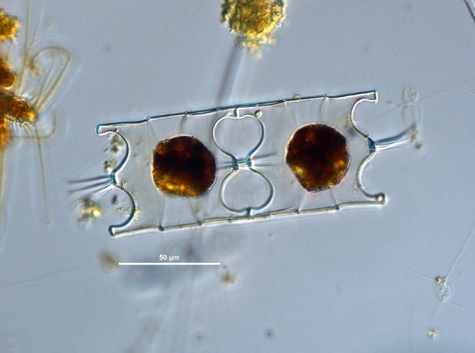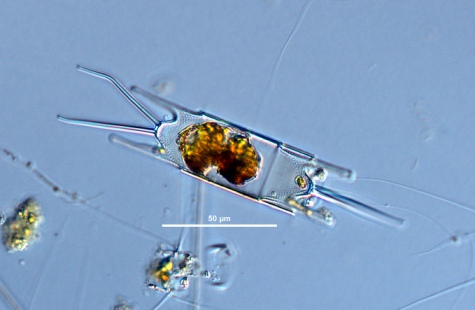




|
Synonym(s)
Heterotypic
A difference in type. In naming species, a heterotypic synonym is one that comes into being when a taxon becomes part of a different taxon. Compare to homotypic.
(heterotypic)Biddulphia hyalina J.L.B. Schröder (heterotypic)
Biddulphia longicruris Greville 1859 Close
Homotypic
Expressing the same fundamental type or structure; may or may not be symmetrical (e.g., the two valves of a diatom, where they are the same shape and appearance, but one is bigger than the other). In naming species, a homotypic synonym is one that comes into being when a taxon gets a new name (without being added to an already existing taxon).
(homotypic CloseBasionym
The original name for an organism. In botany, the original published nomenclature from which a new binomial nomenclature is derived for a particular group of organisms (Tindall 1999).
basionym)(Guiry and Guiry 2011)
Classification
(Guiry and Guiry 2011)
Lifestyle
Description
Lanceolate
Lance-shaped. Having a wider rounded base and tapering towards the tip.
lanceolate, each with two long, tapering and slightly divergent horns. Adjacent cells are united by these horns CloseProcess
A natural projection or appendage on an organism.
(processes). The centres of the valve faces are conical, with two long and divergent CloseSpine
In some diatoms, "closed or solid structures projecting from the cell wall;" in dinoflagellates, solid projections that usually taper to a point.
spines (external tubes of CloseLabiate process
In diatoms, a simple slit in the valve wall with two internal lips, one on each side of the slit. They can be useful in identification because they are positioned differently in different species (Horner 2002).
labiate processes) that extend beyond the horns. Thin CloseSiliceous
Describing the character (i.e., white, shimmery) or chemical presence silicon dioxide (SiO2) as a component of phytoplankton cell covering.
siliceous membranes are sometimes present between adjacent cells. Chloroplasts are numerous, small and located near the valve walls; the cell CloseNucleus
(plural: nuclei) In eukaryotic cells, a membrane-bound organelle that contains the cell's genetic information; the nucleus controls the activities of the cell by controlling gene expression.
nucleus is central. Cells are yellow-brown in colour (Cupp 1943).Costate ocellus
"A plate of silica pierced by closely packed pores" with siliceous ribs between each row of pores (Tomas 1997).
ocelli (Hasle and Syvertsen 1997) and the spine tips are slightly branched (Cupp 1943). "Valves with ClosePunctum
(plural: puncta) A sharp tip or small point on any part of an organism's anatomy.
puncta radiating from a small CloseHyaline
Resembling glass; transparent or translucent.
hyaline central area, forming concentric ellipses on each half of the valve, in nearly parallel rows near base of valve CloseMantle
In diatoms, "the part of a valve that extends from the valve face, forming the valve edge." It is visible when the frustule is viewed in girdle view (Spaulding 2010).
mantle. CloseGirdle
In diatoms, the portion of the cell wall between the two valves of a cell; made up of intercalary bands (bands closest to the valves) and connecting bands (bands in the middle of the girdle). In dinoflagellates, the equivalent of a cingulum or transverse furrow (Horner 2002).
Girdle zone with fine, parallel, vertical rows of puncta. CloseIntercalary bands
Girdle bands that are furthest away from the valve (Smithsonian 2011).
Intercalary bands sometimes present, finely ClosePunctated
Marked with tiny coloured spots or depressions.
punctated, in vertical rows" (Cupp 1943).Measurements
Apical
(axis, spine) The region of the apex or point. Refers to the most anterior point or region of the cell (HPP 2003).
(apical axis): 15 - 110 μmValve Close
Areola(e)
In diatoms, the regularly repeated hexagonal holes on the valve walls (HPP 2003).
areolae: 12 - 17 in 10 μmBand areolae: 18 - 21 in 10 μm
(Cupp 1943)
Similar species
Harmful effects
Habitat
Distribution
Subtropical to temperate regions (Cupp 1943).
Often blooms in autumn in Saanich Inlet, BC (Sancetta 1989).
"Reported north to the Strait of Juan de Fuca. Most abundant in warmer waters. Common at Point Hueneme and south to 17°41'; N" (Cupp 1943).
Growth conditions
Environmental Ranges
Bloom characteristics
References
Cupp, E. E. 1943. Marine Plankton Diatoms of the West Coast of North America. University of California Press. Berkeley, California. 238.
Guiry, M. D. and Guiry, G. M. 2011. Odontella longicruris (Greville) Hoban. http://www.algaebase.org/search/species/detail/?species_id=39270. Accessed 19 Nov 2011.
Hasle, G. R. and Syvertsen, E. E. 1997. Marine diatoms. In: Tomas, C.R. (ed.) Identifying Marine Phytoplankton. Academic Press, Inc., San Diego. 5-385.
Sancetta, C. 1989. Spatial and temporal trends of diatom flux in British Columbian fjords. Journal of Plankton Research. 11(3): 503-520.
